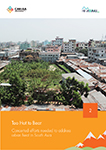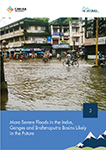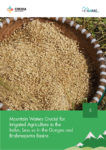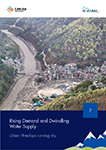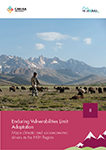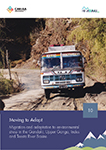Even 1.5 Degrees is Too Much: Rising temperatures and wetter futures in South Asian glacier and snow-fed river basins
HI-AWARE Brief - 1
Key Message: The Indus, Ganges and Brahmaputra river basins are extremely susceptible to temperature increase. Under a 1.5 °C global warming scenario, these river basins would warm up by more than 2 °C on average by the end of this century. At higher altitudes this warming will be even more marked, due to elevation dependent warming. A 2 °C global warming scenario could lead to a warming of around 2.7 °C in these glaciated river basins. Currently, more likely climate change scenarios, specific for these river basins, suggest regional temperature increases between 3.5 and 6 °C by 2100. The majority of the projections also indicate overall wetter conditions in the future and increases in extreme precipitation events. This will lead to significant losses in glacier volume, from 36 to 64%, depending on the warming scenario, and impact timing of water flows and water availability.
Too Hot to Bear: Concerted efforts needed to address urban heat in South Asia
HI-AWARE Brief - 2
Key Message: Heat waves are expected to increase in intensity and duration in South Asia. Heat thresholds in cities are exceeded months on end already. Individual solutions for keeping houses and neighbourhoods cool will not be sufficient – concerted efforts are needed at the urban landscape, community and individual levels to address the challenge of increasing urban heat in South Asia.
More Severe Floods in the Indus, Ganges and Brahmaputra Basins Likely in the Future
HI-AWARE Brief - 3
Key Message: Floods will become more frequent and severe in the mountainous and downstream areas of the Indus, Ganges and Brahmaputra river basins, because of an increase in extreme precipitation events. Depending on the climate change scenario, the severity of flood events is expected to more than double towards the end of the century. Flood-resilient housing shows promise as an adaptation option to address this hazard.
Floods Need Not Spell Doom if Planning and Management are Inclusive
HI-AWARE Brief - 4
Key Message: Farmers in South Asia historically appreciated moderate seasonal floods, as these brought sediments with nutrients, water for irrigation, replenished groundwater and revived water bodies. But, scenarios have changed, and flooding is becoming more destructive.
Floods need not spell doom if river management, including planning and control, take into account people’s concerns, experiences and skill sets. This requires an approach that focuses on balanced interaction between the ecology and human systems at basin level in the Hindu Kush Himalayan (HKH) region.
Climate and Flood Resilient (CFR) housing on the floodplains, consisting of raised and protected plinths, provisions for safe drinking water, EcoSan toilets and solar power, can prevent displacement and maintain health conditions during floods. These low-cost innovations can equip communities to become resilient to extreme and frequent riverine and flash floods.
Mountain Waters Crucial for Irrigated Agriculture in the Indus, Less so in the Ganges and Brahmaputra Basins
HI-AWARE Brief - 5
Key Message: 130 million farmers in the downstream plains of the Indus and the north-western part of the Ganges basin depend on water originating from glacier and snow melt from the mountains.
In terms of crop production, 9% of the ~46 million metric tonnes of wheat that is harvested each year in the Indus Basin can be attributed to water from glacier and snow melt. Similarly, 15% of the annual 19 million metric tonnes rice production, 28% of the 4 million metric tonnes cotton and 17% of the 53 million metric tonnes of sugarcane can be attributed to this meltwater. In the Ganges Basin, 3% of cotton production and 7% of sugarcane production can be attributed to meltwater.
Discharge from glacier and snow melt and groundwater provide a reliable supply of irrigation water during parts of the growing season when other water sources are scarce. Any changes in the future availability of meltwater or further groundwater depletion will therefore impact agriculture.
Understanding the links between sources of water demand and sources of water supply is important for developing appropriate adaptation measures. In HI-AWARE we developed a water resources model to help understand risks and to evaluate solutions to manage the water budget.
Socio-economic Development, not Climate Change, the Main Driver of the Future Water Gap in the Indus, Ganges and Brahmaputra Basins
HI-AWARE Brief - 6
Key Message: Water consumption in downstream areas of the Indus, Ganges, and Brahmaputra (IGB) basins is projected to increase by 24%, 42% and 107%, respectively, during the 21st century.
Water use for industrial and domestic purposes is projected to increase three to seven fold. Although it is currently small compared to the volume of water used in agriculture, it will form a significant portion of total water use in future.
Mean annual water availability is likely to increase by 36-42%, 37-46% and 17-46% in the Indus, Ganges and Brahmaputra, respectively, due to an increase in precipitation that is projected consistently across climate models for all three river basins .
The increase in water availability will be stronger in the upstream parts of the three basins, which will increase the dependency of downstream water users on upstream water resources.
We estimate that the current blue water gap, based on unsustainable groundwater withdrawals, is 83 km3/year in the Indus and 35 km3/year in the Ganges, and will increase by 7% and 11% towards the end of the century. Socio-economic developments leading to increased demand are the main driver of the increasing water gap.
Rising Demand and Dwindling Water Supply: Urban Himalaya running dry
HI-AWARE Brief - 7
Key Message: The water demand-supply gap in 8 surveyed towns across the HKH region is 20-70%. There is a high dependence on springs (ranging between 50-100%) for water supply in three-fourths of the urban areas of the Himalaya. The gap between demand and supply may double by 2050 in a business as usual scenario. A holistic approach to manage water that includes springshed management along with planned adaptation is of the utmost importance for securing safe water supply in the urban Himalaya. Along with springshed management, other options could be explored in the wake of rising water demand and use.
Enduring Vulnerabilities Limit Adaptation: Major climatic and socioeconomic drivers in the HKH Region
HI-AWARE Brief - 8
Key Message: Vulnerabilities are shaped by the interaction of both climatic stresses and socio-economic drivers and conditions in the local context. They vary across geographical locations, socio-economic conditions, livelihood patterns and governance structures.
- Poor, socially excluded and marginalized groups are the most vulnerable
- Relevant policies, strategies and plans should address differential vulnerabilities
- Greater resources allocations are to be made for the climate affected HKH region and the most vulnerable communities and groups
Changing Genderscapes In the Hindu Kush Himalaya, but Unchanging Institutions and Policies
HI-AWARE Brief - 9
Climatic stressors and socio-economic changes are changing traditional genderscapes in farming communities. Changes are taking place demographically, in the roles and responsibilities of women and men, and the domains and spaces they occupy. This is mostly due to the long-term migration of men seeking alternate income sources outside their base locations. To some extent, these changes have enhanced women’s capacities. However, they have also increased women’s vulnerabilities due to weak implementation of existing measures or lack of sufficient policies to safeguard the increased involvement of women in public spaces.
There is an opportunity to capitalise on the improved skills of women, and their new-found confidence and capabilities through initiatives promote women as leaders.
Urgent actions are needed to bring changes in the institutional and policy domains to ensure women’s security and participation by regulating markets and promoting gender friendly technologies that support resilient livelihoods.
Moving to Adapt: Migration and adaptation to environmental stress in the Gandaki, Upper Ganga, Indus and Teesta River Basins
HI-AWARE Brief - 10
Key Message: Labour migration in the Hindu Kush Himalaya boosts household adaptive capacities by spreading risk and diversifying livelihoods. It is incumbent on policy makers to make migration more beneficial for people, and to help build household resilience in the face of environmental change. However, migration is a costly and complicated pathway, which is not available to, or feasible for, all households. Thus, other in-situ adaptation options are equally important.
- 1
- 2


